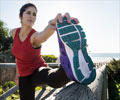
‘Maximal running shoes may increase injury risk among runners as runners who wear these shoes experience a higher impact peak and increased loading rate which are both associated with a greater likelihood of injury.’
Tweet it Now
The study is believed to be the first rigorous analysis of impacts associated with maximal shoes. Maximal running shoes feature increased cushioning, particularly in the forefoot region of the midsole, and have gained popularity since being introduced in 2010. More than 20 varieties of maximal shoes are on the market.
Runners wearing maximal shoes, the researchers wrote, have reported feeling the extra cushion after running two to three miles. As a result, the researchers did not expect to find increases in impact peak or loading rate in runners wearing maximal shoes.
In the FORCE Lab study, researchers evaluated the impacts on runners' feet and legs before and after a simulated 5,000 meter (about 3 miles) run on a treadmill. Each subject wore a neutral running shoe (New Balance 880) for one test and then, after a seven to 10-day waiting period, repeated the procedure with a maximal shoe (Hoke One One Bondi 4). In each test, 3D movements and forces were measured by monitoring reflective markers placed on the runners' shoes and legs and by having the subjects run over a "force plate" that recorded the forces being applied as the runner's foot hit the surface.
"We were surprised by these results," said Christine Pollard, director of the FORCE Lab and an associate professor of kinesiology. "We thought we would see the opposite. Typically, increased cushioning results in a reduction in the impact peak and loading rate of the vertical ground reaction force. We suspect that the large amount of cushioning across the entire midsole caused the runners to rely more on the shoe than on their own internal structures to attenuate these forces."
Advertisement
The research is a first step in gathering evidence on the effects of maximal running shoes on runners' injury risks, said Pollard, who is also a licensed physical therapist. Maximal shoes are becoming very popular, but without controlled studies, clinicians have been unable to make science-based recommendations to runners.
Advertisement
The study is published in The Orthopaedic Journal of Sports Medicine.
Source-Eurekalert













